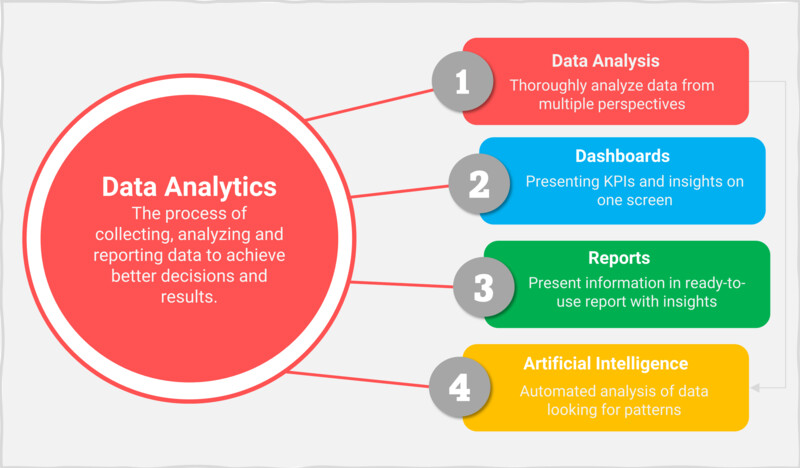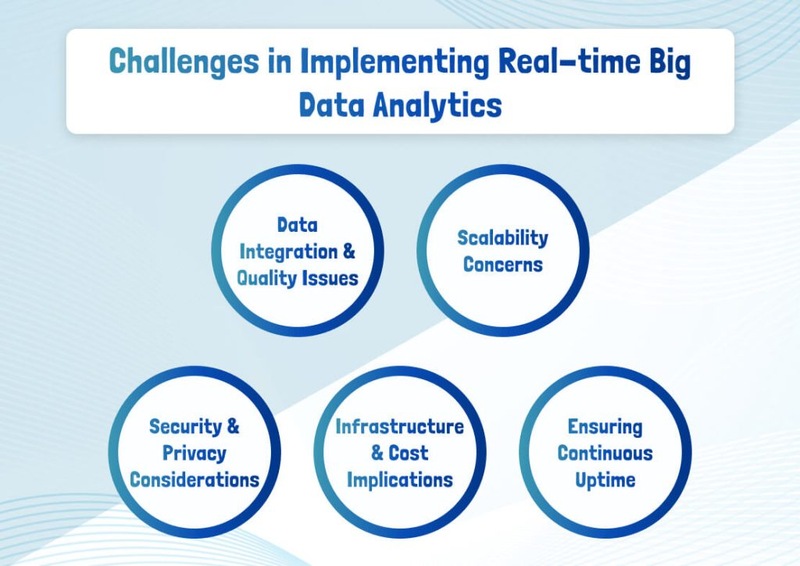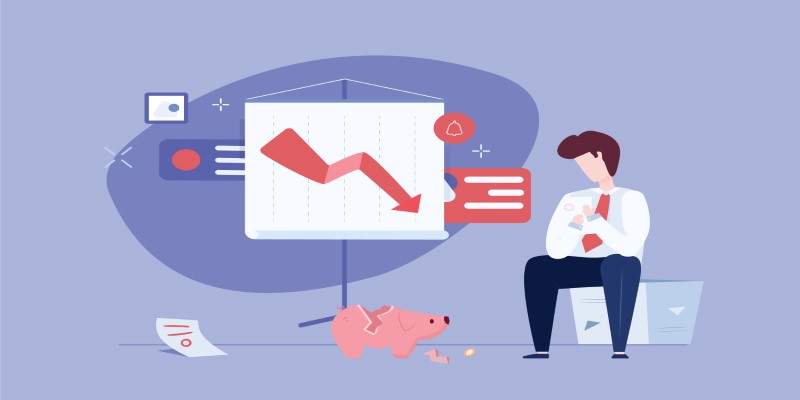All About Data Analytics
May 19, 2024 By Triston Martin
In this era of technology, every type of organization needs data analytics. Data analytics is the method of examining big sets of information to find secret patterns, links, and understandings. It uses different methods and instruments to get useful details from raw data that can be used by businesses in making decisions and getting ahead in their markets.
Exploring Data Analytics Techniques
The field of data analytics includes many methods, with each having a unique function in drawing understanding from information. Descriptive analytics acts as the first stage, giving a picture of past data trends and models. Diagnostic analytics go further, finding out why things happen and discovering cause-effect relationships. Predictive analytics, it's an approach that looks into the future. This method uses statistical models and algorithms from machine learning to anticipate coming trends and behaviors. Lastly, prescriptive analytics gives suggestions for actions based on what we predict with predictive insights. These suggestions help decision-makers in choosing the best strategies.

Moreover, data analytics encompasses more intricate methodologies like text analytics, sentiment analysis, and network analytics. These specific techniques help businesses to draw useful knowledge from unstructured data sources which may include things such as text documents, social media interactions, or even network ties. By making use of both classic and complex analytical methods together, companies can obtain a complete comprehension of their data and push for informed decisions effectively.
- Interdisciplinary Approach: Incorporating expertise from diverse domains such as statistics, computer science, and domain-specific knowledge enhances the effectiveness of data analytics techniques.
- Continuous Improvement: Regular evaluation and refinement of analytics models and methodologies are essential to ensure their relevance and accuracy in evolving business environments.
Applications Across Industries
Data analytics is a force that brings transformation in different fields, changing the way things are done and encouraging fresh ideas. For example, in finance data analytics helps to find frauds, evaluate risks, and make better investment plans using algorithmic trading. In healthcare too it is beneficial for studying the medical records of patients to provide personalized care along with predicting disease results and improving treatment planning through data analytics. Data analytics helps retailers make their inventory levels more efficient, predict what consumers will want, and customize marketing methods for various customer groups.
Also, data analytics helps to make manufacturing processes smoother, lessen inactive time, and guarantee high product quality. By examining production data instantly, manufacturers can spot inefficiencies, stop equipment breakdowns, and improve how they distribute resources. Moreover, data analytics assists in forecasting maintenance needs. Companies can use this method to schedule repairs beforehand and avoid nonproductive periods that are expensive for the business.
- Ethical Considerations: Organizations must prioritize ethical considerations when implementing data analytics solutions, ensuring the responsible use of consumer data, and safeguarding individual privacy rights.
- Integration Challenges: Seamless integration of data analytics tools with existing systems and workflows requires careful planning and coordination across departments.
Harnessing Big Data
In the time of big data, companies have to handle and study huge amounts of information that come from many different places. Platforms for big data like Hadoop and Spark give them a way to store, process, or analyze structured as well as unstructured data on a large scale at a low cost. By using these types of systems which use distributed computing structures, businesses can manage big sets efficiently so they can find useful information from social media posts along with sensor readings up until Internet-connected things (IoT) items.
Additionally, progress in cloud computing technology has made big data analytics more available for everyone. This means organizations of any size can use the benefits of insights from data without needing to put a lot of money upfront into infrastructure. Analytical platforms that are based in the cloud provide scalability, flexibility, and accessibility which allow businesses to adjust swiftly to market movements and expand or reduce their analytical abilities accordingly.
- Data Governance: Establishing robust data governance frameworks is essential to ensure data quality, integrity, and compliance with regulatory requirements.
- Scalability Challenges: As data volumes continue to grow exponentially, organizations must design scalable architectures capable of processing and analyzing large datasets efficiently.
Challenges and Considerations
Data analytics is full of promise, but groups need to handle many issues for it to be truly effective. Problems with data quality, like having incomplete or wrong information, can reduce the trustworthiness of analytics outcomes and how decisions are made. Worries about privacy when gathering and using individual data demand companies to set up strict safeguards for protecting data as well as adhere to regulations such as GDPR (General Data Protection Regulation) and CCPA (California Consumer Privacy Act).

Additionally, there is a lack of skilled data experts which proves to be a big problem for businesses that want to create and keep strong analytics abilities. They need to find and keep high-quality workers who know data science, statistics as well as machine learning so they can encourage creativity and get the most out of their data assets. Making sure of the safety of information and following rules related to specific industries are also very important in keeping trustworthiness when it comes to making decisions using data.
- Data Integration Complexity: Integrating data from disparate sources and systems requires careful planning and execution to ensure data consistency and accuracy.
- Cultural Shift: Embracing a data-driven culture requires organizational buy-in, leadership support, and investment in training and development programs to foster data literacy and empower employees to leverage data effectively.
Future Trends and Innovations
With the continuous growth of technology, data analytics is ready to experience more progress and new changes. This will bring fresh chances for groups in different fields. Artificial intelligence and machine learning algorithms are being more commonly added to data analytics processes. They help in automating tasks, discovering intricate patterns, and improving decision-making abilities. With the use of analytic solutions driven by AI, organizations can understand more about the data they have collected, find hidden opportunities within it, and manage risks better too.
Additionally, edge computing and real-time analysis assist organizations in gaining knowledge nearer to the data's origin. This aids in reducing response durations and enhancing flexibility within dynamic situations. Edge analysis refers to the processing of data at the network's edge, which decreases delay and bandwidth needs while permitting immediate decision-making in IoT applications, self-driving cars, and clever infrastructure projects. The combination of edge computing with real-time analytics has the potential for organizations to discover fresh avenues for innovation as well as increase their effectiveness and competitiveness within this digital era.
- Ethical AI Adoption: Ensuring transparency, fairness, and accountability in AI algorithms and decision-making processes is crucial to building trust and mitigating potential biases.
- Data Democratization: Empowering employees with self-service analytics tools and capabilities enables organizations to foster a culture of data-driven decision-making and innovation at all levels.
Conclusion
To end, the process of data analytics is crucial for encouraging organizational growth, creativity, and competitiveness in a world that relies on data today. By grasping its basics, examining different methods, and using big data effectively businesses can find important knowledge to make smart choices and reach their strategic goals in many different industries. But it's very important to handle problems and keep updated with new styles to use all the power of analytics on data efficiently.
-
 Banking Feb 07, 2024
Banking Feb 07, 2024Handling Bills Amidst Bank Website Downtime: What You Need to Do
Ever faced the panic of your bank's website crashing when bills are due? Uncover practical steps to stay in control and navigate financial waters smoothly.
-
 Know-how May 20, 2024
Know-how May 20, 2024Understanding Commercial Property Insurance: A Comprehensive Guide
An essential guide to securing your business with commercial property insurance, covering risk management, employee safety, and emerging insurance trends.
-
 Know-how Nov 28, 2023
Know-how Nov 28, 2023Flexible Fuel Vehicles
Flexible fuel vehicles, often known as FFVs, are automobiles that can operate on either regular gasoline or a mixture of gasoline and ethanol that contains as much as 85 percent ethanol.
-
 Mortgages May 20, 2024
Mortgages May 20, 2024Unveiling B2B Transactions
Comprehending how B2B transactions and commercial connections function is crucial in today's finance realm.
